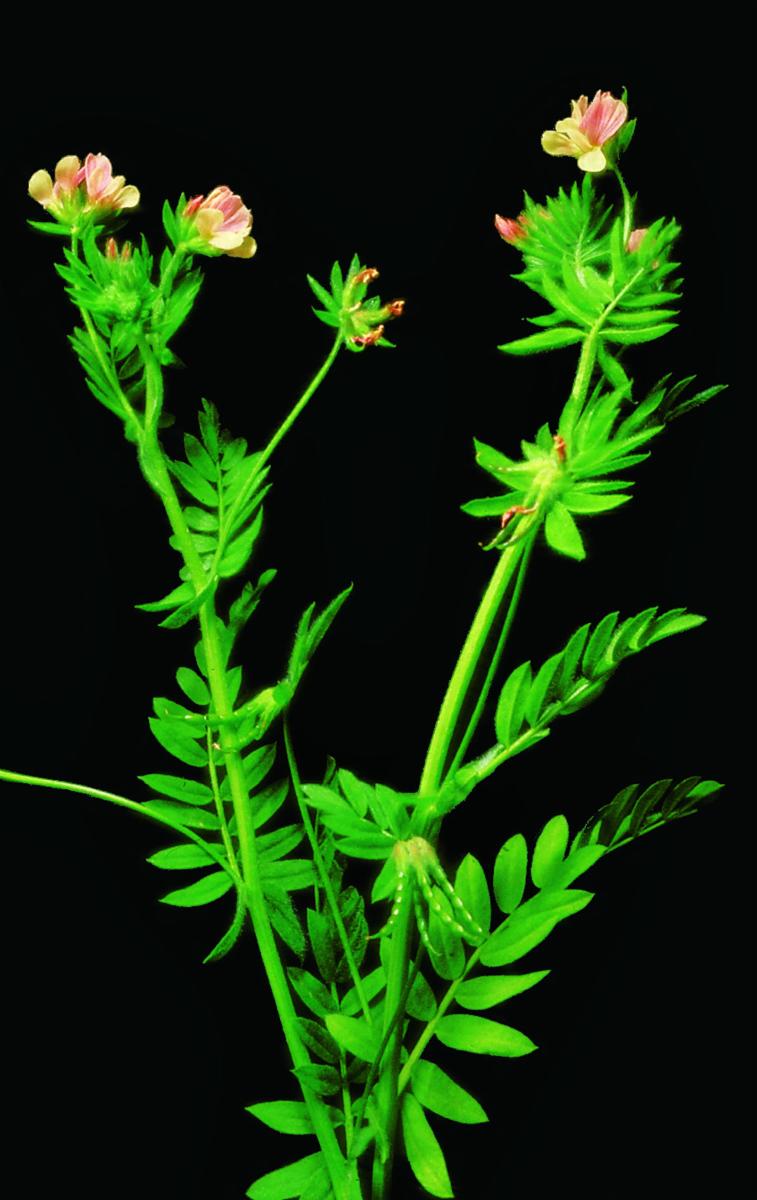Straw Serradella
ornithopus sativus
Also known as: ["Straw Serradella","Common Serradella"]
Overview
A leguminous plant native to the Mediterranean region, valued for its nitrogen-fixing properties and use in pasture improvement.
Benefits & Perks
["drought tolerant","wildlife attractant (bees, butterflies, birds)","nitrogen-fixing"]
Botanical Classification
| Phylum: | Magnoliophyta |
| Class: | Magnoliopsida |
| Order: | Fabales |
| Family: | Fabaceae |
| Genus: | Ornithopus |
| Botanical Name: | Ornithopus sativus |
Plant Characteristics
Basic Information
- Category: Herbs & Weeds
- Suitable Location: open field or garden bed
- Suitable For:
- Is Weed: No
- Allergenicity: low
Environmental Needs
- Climate: {"temperatureRange":"5–30°C"}
- Hardiness: {"zones":"6–9"}
- Misting: rarely required
- Drainage: Fast-draining to prevent waterlogging.
- Soil Type: Well-draining, loamy soil with added organic matter.
Maintenance Level
- Maintenance Level: low
- Toughness Level: high
- Pruning Frequency: As needed, typically every 2–3 months or after flowering.
- Pruning Intensity: Light to moderate; avoid heavy pruning unless necessary.
Care Details
Ideal Sunlight Coverage:
Full sun (6–8 hours/day); tolerates partial shade in hot climates.
Sunlight Tolerance Tips:
Acclimate gradually to intense sunlight; protect from harsh afternoon sun; adjust placement based on seasonal light changes.
Care Requirements
Care Difficulty
easymoderate
Sunlight
full sun
Rotate plant for even growth; use sheer curtains in intense sun; avoid direct midday sun in summer.
Watering
every 7–10 days during active growth, reduce in winter
Water thoroughly but infrequently; ensure proper drainage; avoid wetting foliage.
Soil
well-drained, sandy loam
pH: Slightly acidic to neutral (pH 6.0–7.0).
Use a mix of potting soil and perlite; avoid heavy clay soils; ensure good drainage.
Temperature
Prefers 60–75°F (15–24°C); tolerates cooler temperatures but not frost.
Protect from frost; avoid sudden temperature swings; adjust watering in heat.
Fertilizing
every 4–6 weeks during growing season
Apply fertilizer after watering; use a nitrogen-rich formula for leafy growth; flush soil occasionally to prevent salt buildup.
Propagation
Methods
Seed propagation is most common; stem cuttings can also be used.
Step-by-Step Propagation Guide
- Prepare medium.
- Sow seeds or take cuttings.
- Provide warmth and humidity.
- Transplant once established.
Best Time: Spring or early summer when the plant is actively growing.
Environment
Warm, humid environment with indirect light; maintain consistent moisture.
Medium
Well-draining seed starting mix or cactus mix with perlite.
Hormone
Not typically required for seeds; rooting hormone can aid stem cuttings.
Timeline
Seeds germinate in 2–4 weeks; cuttings root in 3–6 weeks.
Tools Needed
Seed trays, rooting hormone, misting spray bottle, heat mat.
Quick Tips
Use fresh seeds for best germination; keep soil consistently moist; provide bottom heat for faster rooting.
Pruning & Repotting
Pruning Guide
Method
Pinch back tips for bushier growth; trim leggy stems; remove spent flowers.
Pruning Plan
Prune to maintain shape, encourage bushier growth, and remove dead or diseased parts.
Tools
Pruning shears, sharp scissors, gloves.
Checklist
Sterilize tools; prune dead/damaged parts; shape the plant; clean up debris.
Repotting Guide
Best Season
Spring, before the active growing season begins.
Pot Size
Increase pot size by 1–2 inches in diameter; avoid oversized pots.
Method
Use fresh, well-draining soil; gently tease out root bound plants; ensure proper drainage.
Suggestions
Repot every 2–3 years or when roots outgrow the container; beneficial for growth and health.
Checklist
Prepare new pot; trim roots if necessary; use fresh soil; water lightly after repotting.
Advanced Care Tips
Watering Mastery
Watering Checklist
Check soil moisture; water deeply; ensure drainage; avoid wetting leaves.
How to Apply Water Properly
Water at the base of the plant, ensuring moisture reaches the root zone; allow excess water to drain away; water in the morning to reduce evaporation.
Watering Schedule Tips
Water deeply once the top inch of soil is dry; reduce frequency in winter to prevent root rot.
Soil Improvement
Add perlite or sand for drainage; incorporate compost for fertility; ensure aeration with organic matter.
Temperature Stress Management
Signs of Temperature Issues
Wilting, yellowing leaves, or stunted growth in extreme heat or cold.
Cold Stress
Growth slows or halts; may experience leaf drop or dieback in freezing temperatures.
Solution: Provide frost protection; move to a warmer location; avoid overwatering in cold conditions.
Hot Stress
Leaves may scorch, wilt, or drop; growth may slow in excessive heat.
Solution: Provide shade during peak heat; increase watering; improve air circulation.
Fertilizing Guide
Fertilizing Checklist
Check fertilizer type; dilute properly; apply during growing season; avoid winter feeding.
Fertilizing Method
Use a balanced, water-soluble fertilizer diluted to half strength; fertilize every 4–6 weeks during growing season; avoid fertilizing in winter.
Common Problems & Solutions
Toxicity Warning
Cats
Non-toxicOrnithopus sativus is not known to be toxic to cats under normal conditions of exposure or consumption.
⚡ Toxic If:
not applicable
Dogs
Non-toxicOrnithopus sativus is not known to be toxic to dogs under normal conditions of exposure or consumption.
⚡ Toxic If:
not applicable
Humans
Non-toxicOrnithopus sativus is not known to exhibit toxic properties to humans under normal conditions of exposure or consumption.
⚡ Toxic If:
not applicable
Frequently Asked Questions
Q: Is Ornithopus sativus toxic to pets?
A: No, it is non-toxic to dogs and cats.
Q: What are the primary uses of Ornithopus sativus?
A: It is primarily used for pasture improvement and as a nitrogen-fixing crop.
Q: How does Ornithopus sativus benefit the soil?
A: It fixes atmospheric nitrogen, enriching the soil and reducing the need for synthetic fertilizers.
Quick Reference
| Family: | Fabaceae |
| Care: | easy |
| Light: | full sun |
| Water: | every 7–10 days during activ |
Get Expert Care Tips
Download the Plantious app for personalized care reminders and plant identification!
Google Play App Store







